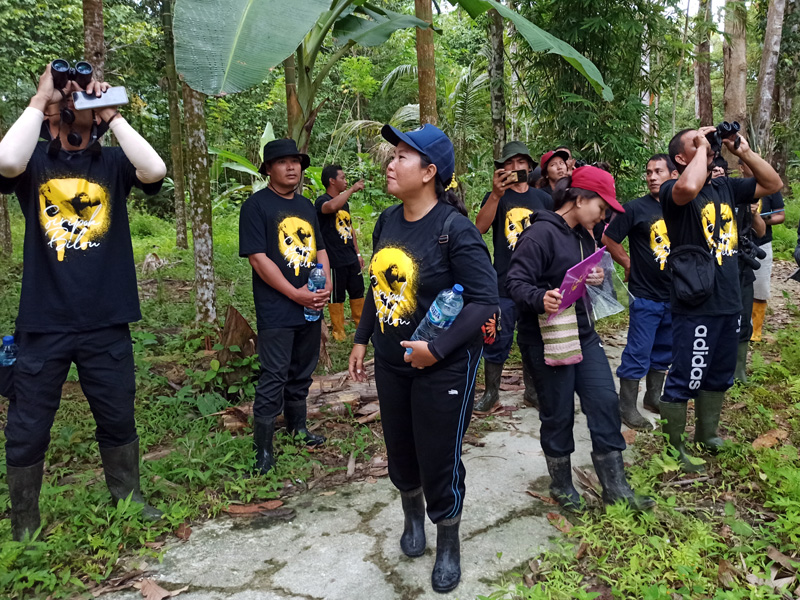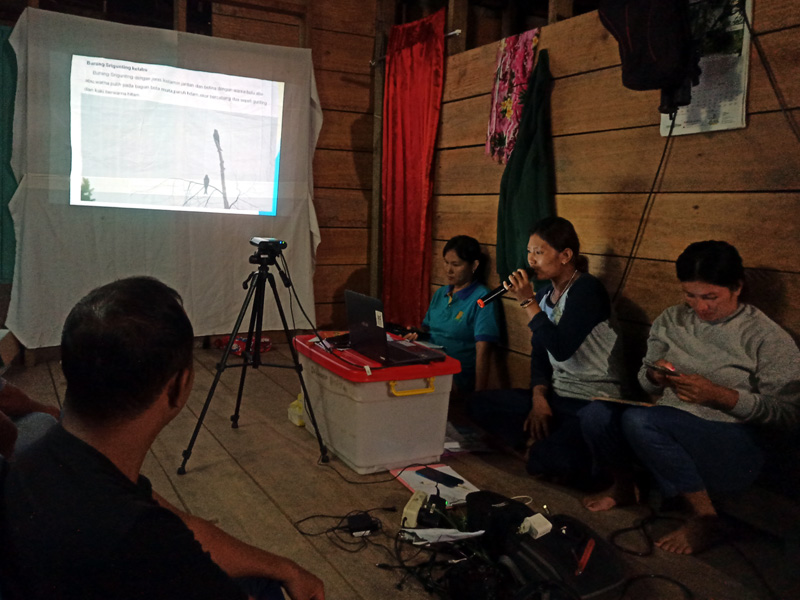by Imam Taufiqurrahman
On the second and third days of training, the participants were invited to make observations in the forest around Toloulaggo Hamlet. Participants were divided into three teams, each of which was provided with various equipment and supplies, such as observation data sheets and binoculars.
On the first day, each team recorded encounters with various species of birds. Some of them are hillminah, limendeu , and rotdot ( in local name). Although none of the team encountered primates directly, they enthusiastically observed the various other biodiversity they encountered. Various types of orchids, mushrooms and medicinal plants cannot escape observation.
The participants were also able to record activities encountered in the forest. As part of an assignment for citizen journalism material, the team discovered that trees had been cut down. The findings were obtained, both from the location of logging marks and the loud sound of a chainsaw that was heard during the observation session.
All findings and observations became the focus of each group’s presentation. This presentation session took place in the evening and was quite lively with questions and answers between the participants.
On the second day, the committee directed the team to a different area. Unfortunately, the observation could only be carried out for a short time because of the heavy rain. However, luck was on Team 2’s side. During that short observation, they were able to find a group of Joja, mentawai langur ( Presbytis siberu). Its existence is only found on Siberut Island. Taxonomically, it is different from its close relatives on the other three Mentawai islands, Sipora, North Pagai, and South Pagai. On these three islands, there is Presbytis potenziani, known as atapaipai.
Both of these species are classified as endangered species. Joja is included in the Endangered or Critical category, while Ataipaipai has an even more serious threat status, namely Critically Endangered or Critical.
Testimonial of participants
Julianus, a Biology teacher at Lentera High School, South Siberut, admitted that he was not satisfied with the course of the training, because he and his team had not managed to see any primates. Julianus hopes that in the future there will be a more focused observation route and have a high chance of encountering primates.
However, Theresia Yuni conveyed a different impression. “I am quite satisfied because I can see directly the presence of primates in their habitat,” admitted the principal of SDN 05 Toloulaggo. It was he and his four team members who managed to find Joja.
Naturally, Yuni felt quite satisfied. He was really lucky, considering that observation was his first experience. “I’ve lived here for ten years, and this is my first time in the Toloulaggo forest,” he admitted.
Meanwhile, Fransiskus Yanuarius Mendrofa from the Mentawai Cultural Education Foundation (YPBM), gave an insight into the difficulty of the participants encountering primates. According to him, this is a real form of threat to Mentawai primates. He also hopes that the participants can become primate ambassadors, bringing experience and knowledge during training to the school community, especially to students or students.
In the closing session, Jeremias Saleuru, a community leader who was present, also shared his experiences. He told a story about when he was still hunting primates. According to Jeremias, he doesn’t always succeed in getting game animals. Many factors could be the cause. “Maybe the weather is not good or there is interference,” he explained. One of the disturbances was the sound of a chainsaw, which the participants heard during the observation.
Despite the dissatisfaction of most participants because they were unable to meet primates, the three-day training in Toloulaggo certainly gave the participants direct experience in animal observation activities. Activities can run according to the theme, Still arepi sabbat still pa’ ugai mateikeccat, uma’, sibabara kabagat leleu Toloulaggo. This sentence means, “Listen to and introduce the existence of primates and birds in the Toloulaggo region.”

